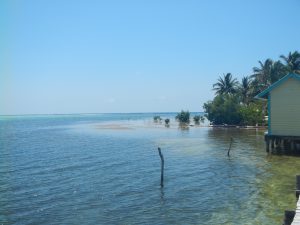I’m up at 5:00 am. My bags are packed. I eat a PB&J, and we are on the road. The drive from the Tropical Education Center to the pier in Belize City isn’t too long – around 45 minutes. Our team transitions to the boat, and we are off on the two-and-a-half hour boat ride to Glover’s Atoll, our home for the next seven days.

Soon after our arrival to Glover’s, we went snorkeling – my first time ever. The colors of the reef seemed like they were from a centuries-old oil painting. I was anticipating a full color pallet of hues, but the corals’ tones were warm-colored and muted.
Snorkeling in the water seemed out of body – like I was an avatar in a video game. Still not fully used to the controls of this unfamiliar type of movement, I felt awkward in the water, despite swimming competitively in high school. Every movement was calculated, taking into full consideration each dimension of my unfamiliar setting – Who is behind me? Will I bump into any coral nearby? Is my snorkel still vertical?
The reef was teeming with busy creatures. During my brief hour-long escapade, I encountered many types of fish, including baby barracuda (Genus Sphyraena), a baby nurse shark (Ginglymostoma cirratum), and a large southern stingray (Dasyatis americana). The only echinoderm I found was the bleached skeleton of a large red heart urchin (Meoma ventricosa) on the seafloor. The skeleton was about 6 inches in diameter and partially covered in algae. I also held a conch shell with a fleshy body inside. His eyes stuck out of his head like the eyes of Mr. Krabs from Spongebob Squarepants. My superstar sighting was a porcupinefish (Family Diodontidae) hiding under a rocky ridge. The fish was difficult to photograph, but with its massive size and bright colors, it was easy to remember.
After the swim, we explored a coral graveyard, studying the skeletons of centuries-old corals. It was interesting to witness how corals vary in formational shape, as well as polyp size and arrangement pattern. After dinner, we closed the day with two taxon briefings (including my own on echinoderms).
My first time in the water was surreal. I am eager for the next wave of adventures tomorrow will bring.
